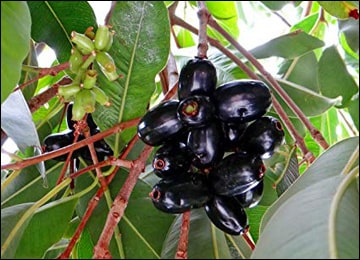
What is Syzygium Cumini?
Syzygium cumini is an important Ayurvedic herb which has been used in Ayurveda for the treatment of diabetes, worm infection, asthma, diarrhea, cough, and cold. The plant is native of India and distributed throughout upper Gangetic plains, Bihar, Orissa. The herb is cultivated widely in Africa. The plant has been successfully introduced in many other tropical countries such as West Africa and the West Indies. Jamun is slow growing plant and grows up to the height of 20-30 meter. The scientific name of the plant is Syzygium cumini and it belongs to Myrtaceae. The plant is also known as Jamoon and Jambul.
It’s an evergreen plant. At the base, the bark is rough and dark in color but becoming lighter grey and smoother higher up. The leaves are 5-25cm long, 2.5-10 cm wide, elliptic, blunt, or tapering to a point at the apex. Leaves have turpentine smell. They are pinkish when young and turns into dark greenish color with yellowish midrib when mature. The flower appears in clusters 2.5-10 cm long. The color is white at first, becoming rose pink and after that shedding down rapidly to leave only with numerous stamens. Fruits appear in a cluster, round, oblong and often curved. On maturity the color turning from green to dark purple or nearly black.
Scientific Classification
- Kingdom: Plantae
- Subkingdom: Tracheobionta
- Superdivision: Spermatophyta
- Division: Magnoliopsida
- Class: Magnoliopsida
- Subclass: Rosidae
- Order: Myrtales
- Family: Myrtaceae
- Genus: Syzygium
- Species: Syzygium cumini
Names
- Latin name – Syzygium cumini
- English name – Java plum, Black plum, jamun, Jamoon
- Hindi name – Jamun, Jambol, Jambul
- Punjabi name – Jamalu
- Malayalam name – Naval
- Bengali name – Kala jam
- Tamil name – Saval naval
- Kannada name – Nerale
- Telugu name – Neredu, Chettu
What are the Medicinal Properties of Syzygium Cumini?
- Rasa (taste): Kashya (astringent), Madhura (sweet), Amla (sour)
- Guna (qualities): Rooksha (dry), Laghu (light to digest)
- Vipaka: (after digestion convert into pungent taste)
- Veerya (potency): Sheeta (cold)
- Effect on tridosha: It balances the Kapha and pitta dosha.
What are the Chemical Constituents of Syzygium Cumini?
The phytochemical studies of Syzygium cumini have identified gallic acid, glycosides, cyaniding glycoside, Jamboline, tannins, triterpenes, beta-sitosterol, essential oils, and myricyl alcohol etc.
- The stem of Syzygium cumini contains Quercetin, ß-sitosterol-D-glucoside, astragalin, Kamepferol-3-0- glucoside, myricetin, and gallic acid.
- Fruit contains Glucose, mannose, fructose, and galactose as the principal sugar. Cyanidine and diglycoside provides colour to the fruit.
- Seeds contain: Jamboline phenolic compound, fat, resin, gallic acid, ferrulic acid guaicol.
- Leaves contain: Gallitannins, monoterpenoid terpinene, terpenolene, borbeneol, terpineol, and eugenol.
- The flower contains oleanolic acid, kaempferol, quercetin, isoquercetin (quercetin-3- glucoside), myricetin- 3 – L – arabinoside, myricetin, quercetin-3-D-galactoside, dihydromyricetin, and acetyl oleanolic acid.
- Roots: New flavonoid myricetin 3-o-robinoside and Myricetin 3-o-glucoside.
What are the Therapeutic Properties of Syzygium Cumini?
Therapeutic Properties of Jamun Fruit:
- Digestive property
- Anti-inflammatory
- Mild astringent
Therapeutic Properties of Jamun Fruit:
- Anti-diabetes
- Astringent
- Antihyperglycemic
Therapeutic properties of Jamun Leaves:
- Antiemetic
- Anti-diabetes
- Anti-hemorrhagic
Therapeutic properties of Jamun Bark:
- Astringent
- Antibacterial
- Anti-dysentery
- Carminative
What are the Health Benefits of Syzygium Cumini?
- Treat heart disorders: Individuals with altered lipid profile and due to hypertensive nature are at high risk of developing heart disorders. Jamun fruit and other parts of the herb contain antioxidant compounds which reduce the oxidative stress. Reduction in oxidative stress in the body further reduce the risk of heart disorders. Jamun pure extracts also protect the cardiac cells from the free radical activities.
- Diabetes: The jamun fruit contains amazing anti-diabetic property, which reduces the blood sugar level in your body. Some antidiabetic compound in jamun fruit converts the starch into energy and keep your blood sugar level in check. The powder of jamun seeds also has an antidiabetic property which enhances the insulin activity in the body and ultimately lowers the sugar level in the blood.
- Improves digestion: Jamun is a rich source of vitamin A and C, which helps to detoxify our body and also helps in proper functioning of the digestive system. Jamun leaves is good in treating the digestion related problems. Jamun solves acidity problem when it is taken along with black salt and roasted cumin powder.
- Supports oral health: Jamun leaves have great antibacterial properties which are good for your oral health. Leaves are astringent due to which they are considered as good for throat problems. They provide strength to teeth and gums. Jamun leaves powder used as teeth powder and it helps in the prevention of gums bleeding.
- Blood purifier: Jamun is a natural blood purifier which helps to overcome the deficiency of iron in the body. Iron ensure that oxygenated blood with a good amount of hemoglobin reaches the various parts of the body. This will also help to keep your skin free from acne.
- Treats respiratory disorders: Jamun bark contains astringent and carminative properties. When the bark of jamun tree boiled in water for 15 minutes, all the properties of bark infused in water. This will helps in treatments of respiratory disorders.
- The other benefits of bark water is to help to treating mouth ulcer, pain in gums and leucorrhoea in women.
This is a very import herb, which has been used in Ayurveda for the treatment of various body ailments, which we are mentioned above. Along with these properties, jamun also helps to increase the stamina and hemoglobin in the body.
